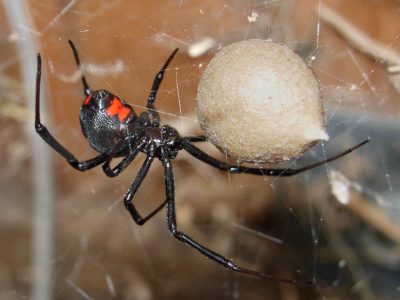Ribbon Snake
Thamnophis sauritus
Ribbon snakes love water, but are excellent climbers too.
Advertisement
Ribbon Snake Facts
- Prey
- Frogs, fish, salamanders
- Group Behavior
- Solitary
- Fun Fact
- Ribbon snakes love water, but are excellent climbers too.
- Most Distinctive Feature
- Three lines running the length of their bodies.
- Diet
- Carnivore
- Average Litter Size
- 3-26 live young
- Lifestyle
- Diurnal
- Common Name
- Ribbon Snake
- Special Features
- Brown, black, olive with a tan, white, blue or yellow stripe
View all of the Ribbon Snake images!
“These tiny snakes give live birth to their young”
Eastern ribbon snakes can grow as long as 35 inches and are similar in appearance to garter snakes. They live in North America. Their diet includes frogs and fish. Ribbon snakes have a shy nature and aren’t venomous. Their lifespan is 10 to 11 years.
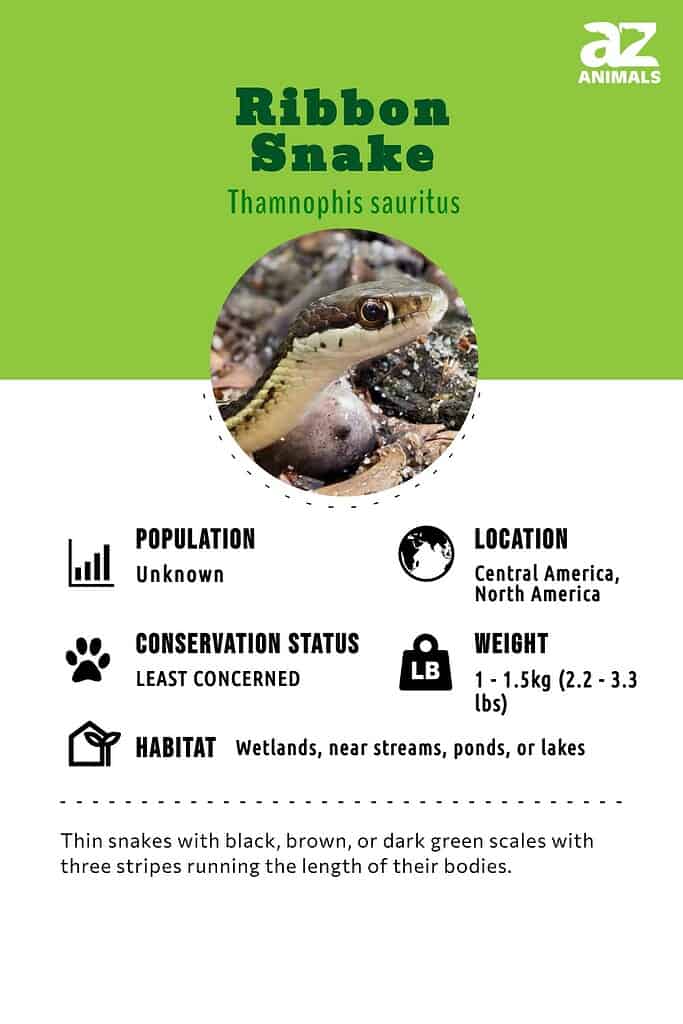
3 Amazing Facts About Ribbon Snakes
• Their tremendous speed helps them capture prey
• The female carries her eggs inside her body
• They can swim and climb trees
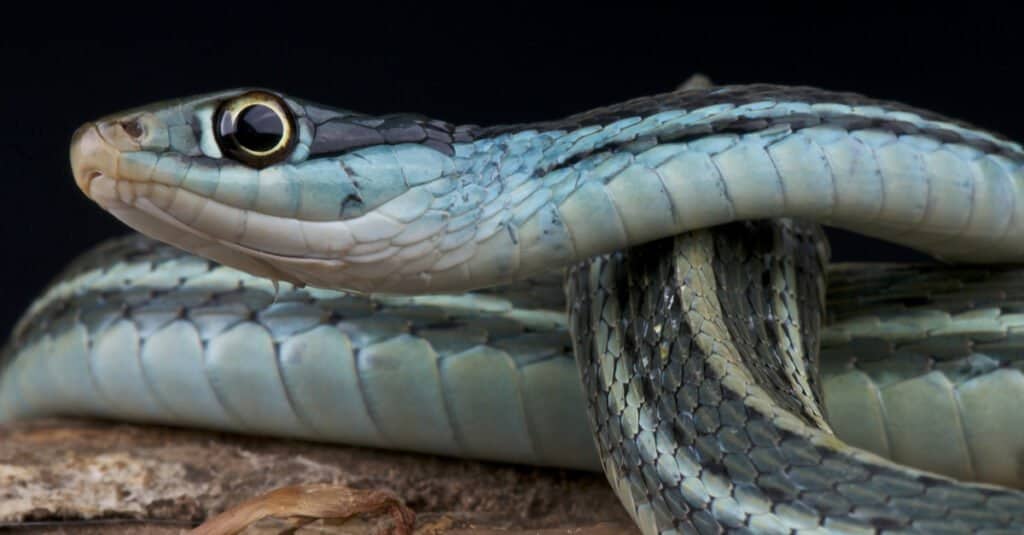
Ribbon snakes of all types live in wetlands or near a stream, pond, or lake.
©reptiles4all/Shutterstock.com
Where to Find a Ribbon Snake
Generally speaking, the ribbon snake is found in North America. But, the specific range of a ribbon snake depends on its type.
Some ribbon snakes are found mostly in the eastern section of the United States while the territory of others extends to western, northern, and southern areas.
All types of ribbon snakes live in wetlands or near a stream, ponds, or lakes. They can move with speed on land and in the water. These snakes are most active in the spring and summer during the breeding season.
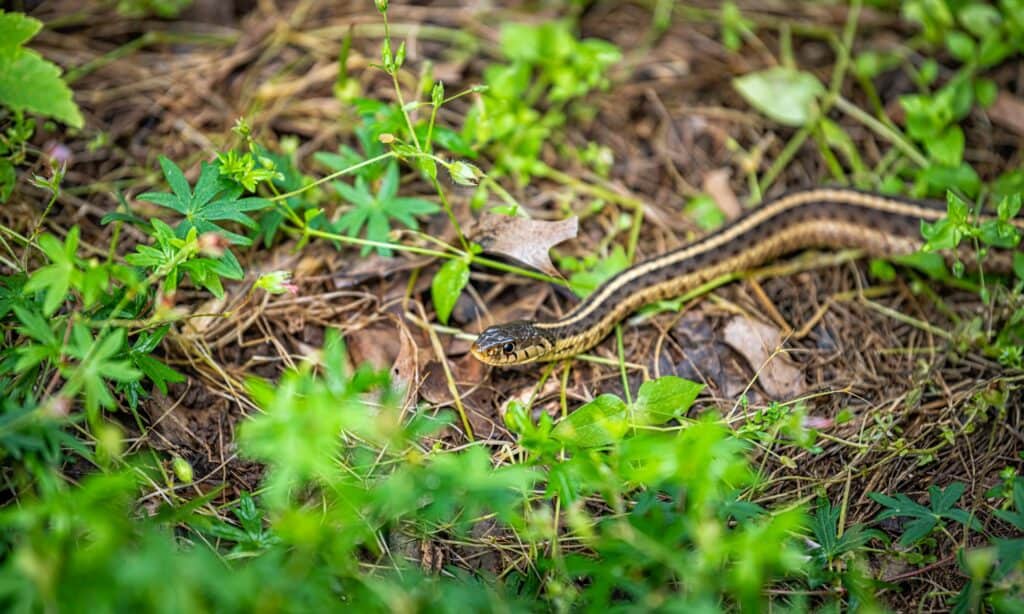
Eastern and Northern ribbon snakes both have brown or black bodies with white or yellow stripes.
©iStock.com/krblokhin
Species
These subspecies of ribbon snake belong to the Colubriae family:
• The Eastern ribbon snake (Thamnophis saurita) is found on the east coast of the United States ranging from New York to Florida. Their territory also extends west to the Mississippi River. It has a brown or black body with yellow stripes.
• The Northern ribbon snake (Thamnophis saurita septentrionalis) has a territory going through Maine, the northern part of Ohio, Indiana, and Michigan. The Northern ribbon snake also lives in the southern part of Ontario and Nova Scotia in Canada. It has a black or brown body with three stripes of white or yellow similar to the Eastern ribbon snake.
• The Western ribbon snake’s (Thamnophis Proximus) range includes Wisconsin and extends south through the United States and into Costa Rica. This is a larger ribbon snake measuring 18 inches to 42 inches.
• The Southern ribbon snake (Thamnophis saurita sackenii) lives in the southern section of South Carolina as well as in Georgia and Florida. These snakes are often found in thickets.
• The Bluestripe ribbon snake (Thamnophis sauritus nitae) occupies Florida’s Gulf Coast. They are known for their black scales and two blue stripes. Bluestripe ribbon snakes are a little smaller than other types of ribbon snakes. These Gulf Coast snakes can be 18 to 25 inches long.
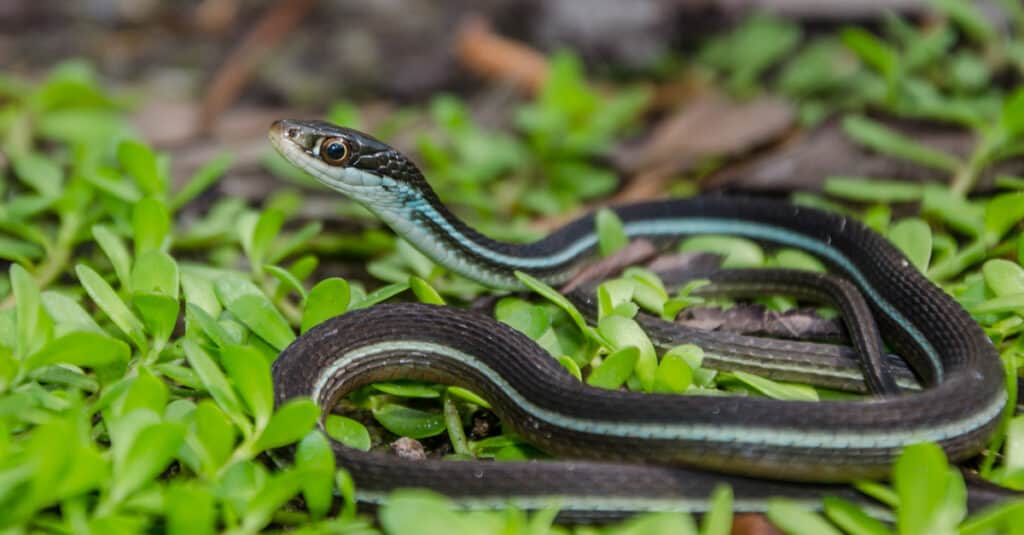
Bluestripe ribbon snakes are native to Florida’s Gulf Coast.
©Jay Ondreicka/Shutterstock.com
Scientific Name
An Eastern ribbon snake’s scientific name is Thamnophis sauritus. It’s also called the common ribbon snake. Thamnophis is its genus and the Latin word sauritus translates to lizard-like. It’s in the Colubridae family and the class Reptilia.
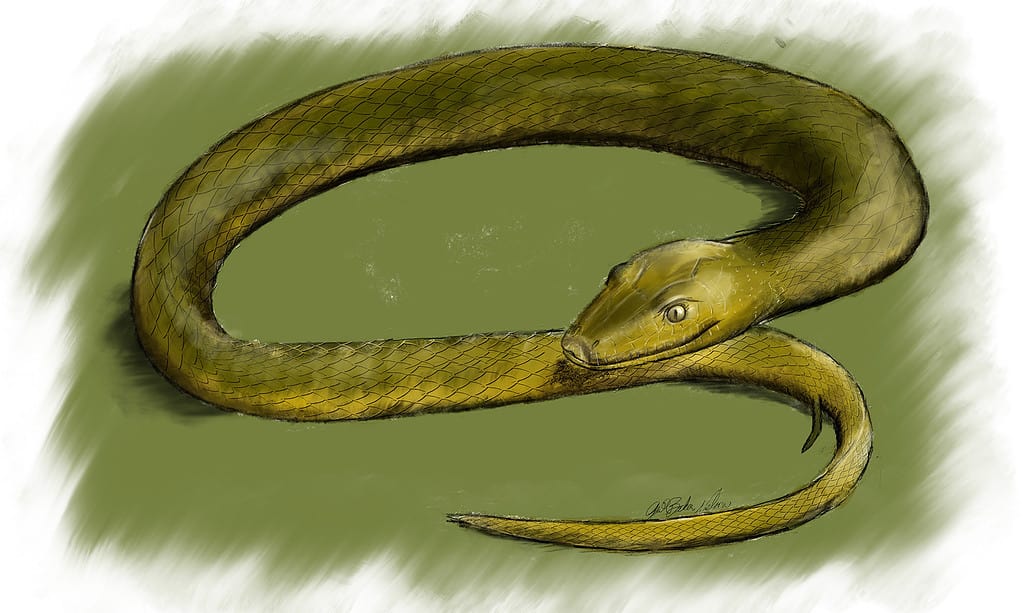
Evolution
Fossil records show that snakes first appeared during the Cretaceous period – although they often retained their hind limbs. The earliest true snake fossils come from the marine simoliophiis, the oldest being Hassiophis terasanctus, dated between 112 – 94 million years ago.
Scientists believe that snakes descended from lizards. Pythons and boas, the most primitive snakes, have vestigial hind limbs and some have remnants of a pelvic girdle, appearing as horny projections.
Many modern snakes originated during the Paleocene, alongside the radiation of mammals that occurred after the extinction of non-avian dinosaurs. The expansion of grasslands in North America led to a major radiation of snakes. During the Miocene, the number of snake species increased with the first vipers and elapids and the diversification of Colubridae.
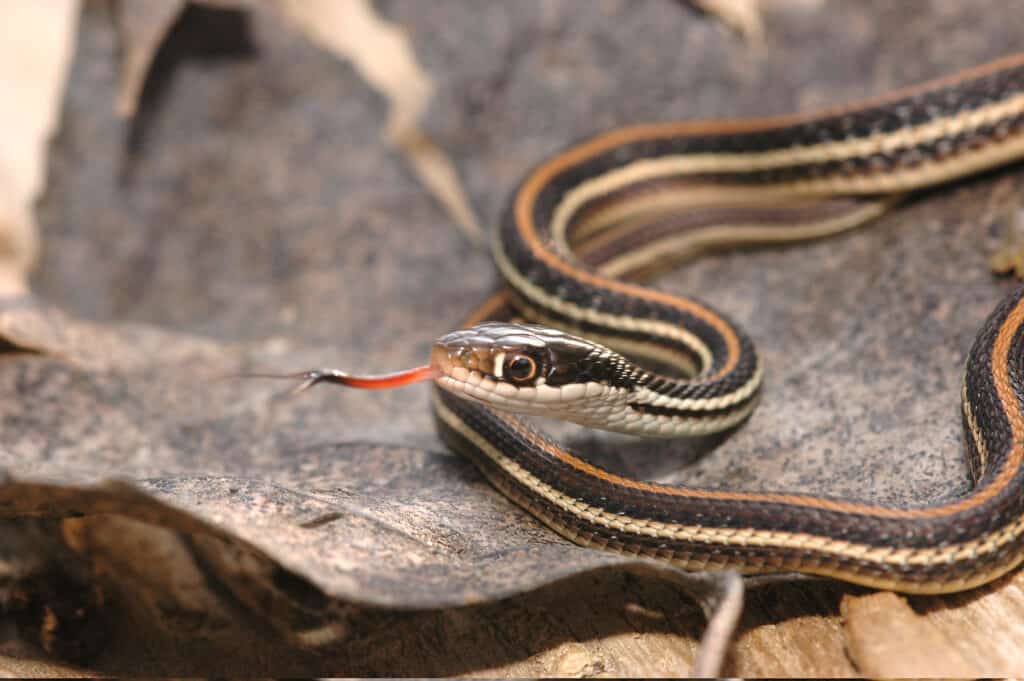
Ribbon snakes, including the Western ribbon snake pictured, have a conservation status of least concerned.
©iStock.com/Shoemcfly
Population & Conservation Status
The IUCN Red List reports the population of the Eastern ribbon snake at over 100,000 adults. They’re considered Least Concern with a stable population.
Appearance and Description
Adult Eastern ribbon snakes have very thin bodies that are 18 to 26 inches long. Its scales are black, brown, or dark green with three yellow, blue, white, or tan stripes running the length of its body. It has one stripe on its back and one on each side. This small reptile has a white or greenish-colored belly. It has two dark eyes with a white marking on the scales in front of each one.
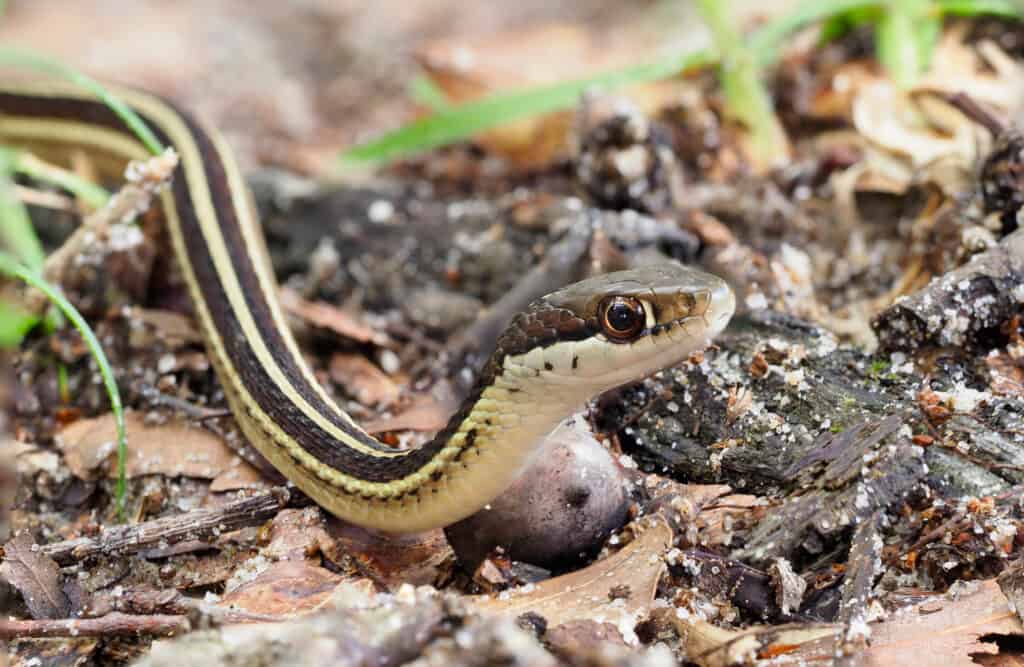
Adult Eastern ribbon snakes grow up to 26 inches long.
©Steve Bower/Shutterstock.com
How to Identify a Ribbon Snake
- Black, olive green, or dark brown
- Three stripes are white, yellow, or blue
- A slender head matching its narrow body
- A white marking in front of each eye
Ribbon Snake vs Garter Snake
Ribbon snakes and garter snakes share a lot of features; strictly speaking, ribbons snakes are a type of garter snake. Both snakes have a dark brown or olive-green body featuring three stripes of yellow or white. They both live in North America. Plus, garter snakes and ribbon snakes give live birth. Furthermore, both of these snakes can be a pet. But, despite all of those commonalities, some things set them apart.
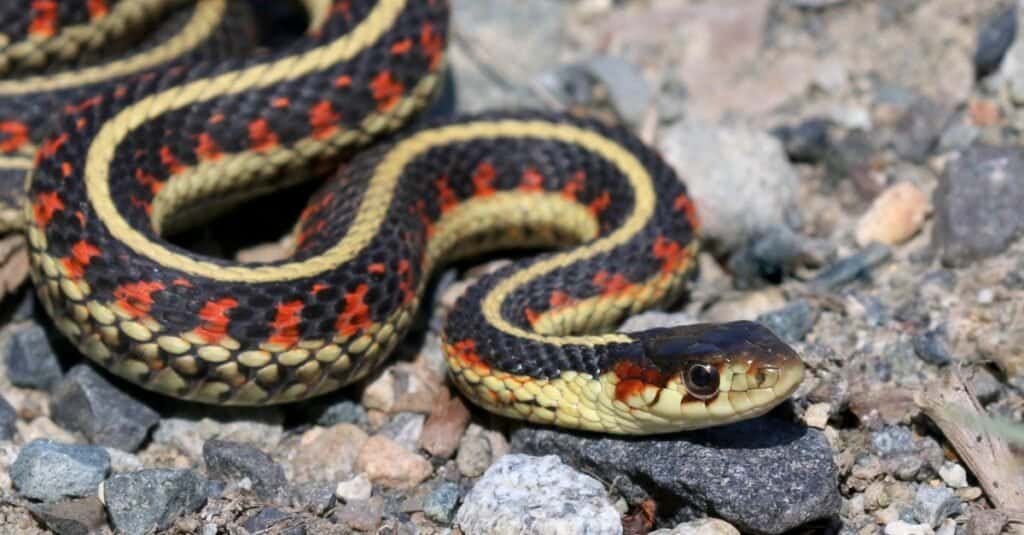
Garter snakes are thicker and lack the white eye markings of the ribbon snake.
©iStock.com/randimal
Though they’re both small snakes, a garter snake has a thicker body than a ribbon snake. A second difference is one you have to look closely to see. A ribbon snake has a white marking in front of each eye whereas garter snakes do not.
In terms of habitat, a garter snake usually lives near ponds, streams, lakes, and marshes. However, they can also make a home away from the water. Alternatively, ribbon snakes restrict themselves to wetlands and shorelines of ponds and streams.
There’s a difference in the diet of these two snakes. Ribbon snakes live around water, so they are known to eat small fish, frogs, and tadpoles. Alternatively, though garter snakes eat frogs and fish, they also include newts and insects in their diet.
Some garter snakes have a mild form of venom and use it to kill their prey. But, though some garter snakes are venomous, this venom isn’t strong enough to affect humans. On the other hand, ribbon snakes are not venomous. These snakes use their great speed to chase and capture prey.
Diet
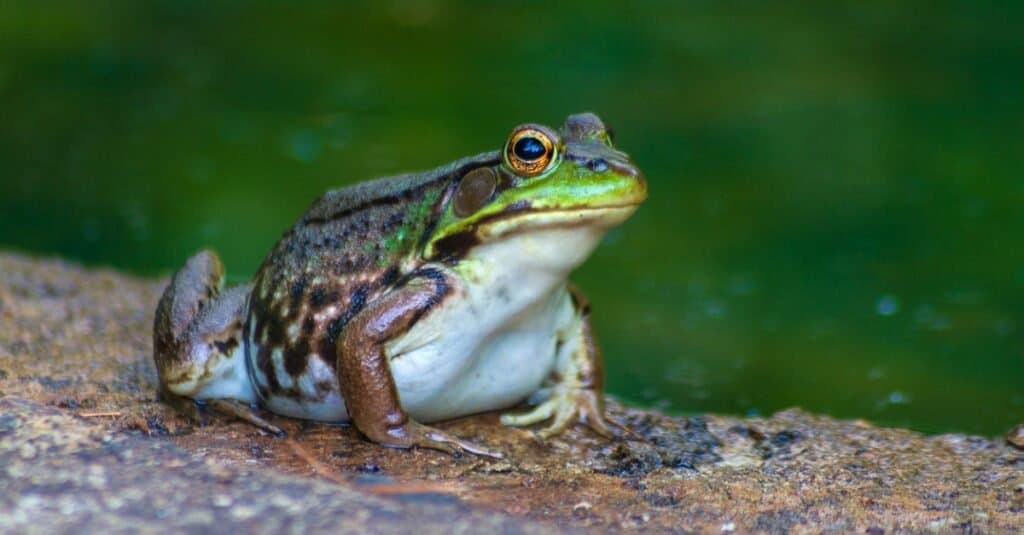
Ribbon snakes eat a variety of aquatic creatures – including frogs, toads, salamanders and tadpoles.
©iStock.com/Corey T. Burns
Ribbon snakes rarely venture away from their wetland habitats, so they eat a variety of aquatic animals, mostly amphibians including frog, toads, salamanders and tadpoles. They will also prey on fish and some invertebrates.
How Dangerous Are They?
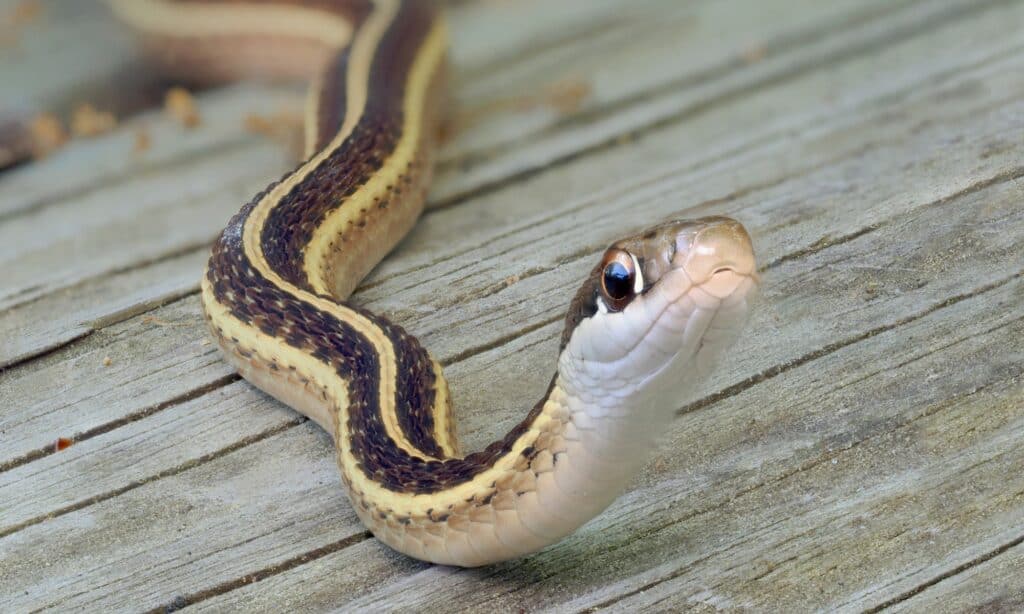
Ribbon snakes are not dangerous to humans and will slither away if approached.
©iStock.com/sdbower
Ribbon snakes are not dangerous to people. Recent research shows that some garter snakes have extremely mild prey-specific venom that may irritate some people. However, there’s very little research on whether all snakes in the Thamnophis genus have this trait or just a few.
They are fast-moving and stay hidden in thickets, marshlands, and around ponds. If a person approached this shy snake, it would immediately try to slither away to safety. Even a pet ribbon snake is going to try to escape a situation if it feels threatened.
Of course, like most snakes, a ribbon snake can bite. For instance, a pregnant ribbon snake may bite a person who tries to capture her.
Though this snake’s bite does hurt a little, it’s not harmful to a person. If it bites, it’s best to wash the area with soap and water, then apply first-aid ointment. If the spot becomes irritated, it’s a good idea to consult a doctor.
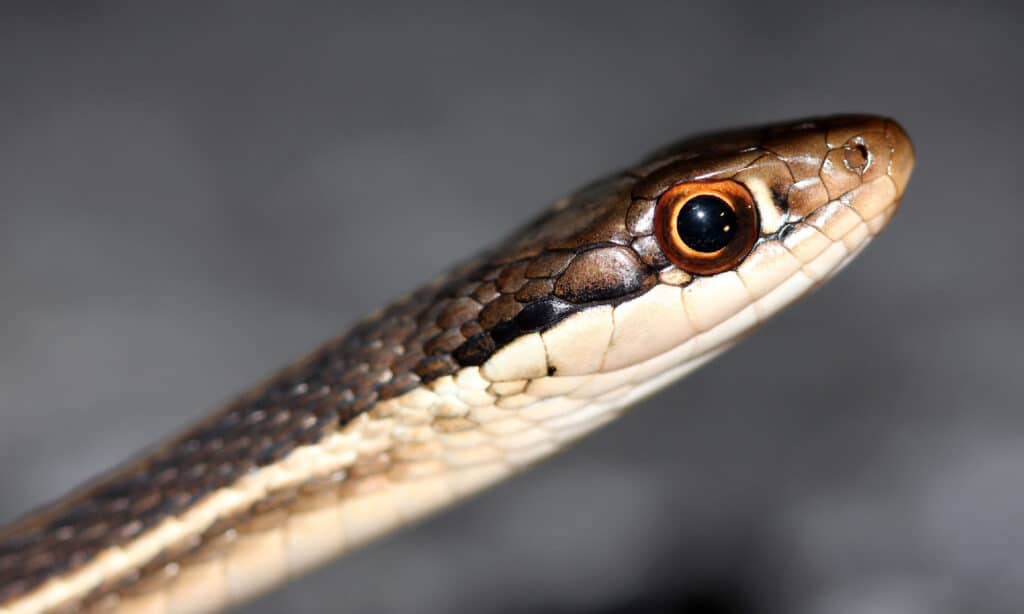
Ribbon snakes are shy and docile – making them popular pets among reptile enthusiasts.
©Ryan M. Bolton/Shutterstock.com
Behavior and Humans
Unless a person lives near a pond, lake, or marsh, they are unlikely to see a ribbon snake. These snakes are shy and aren’t considered pests.
The size and docile nature of this snake have made it a popular pet with some reptile enthusiasts!
Similar Animals
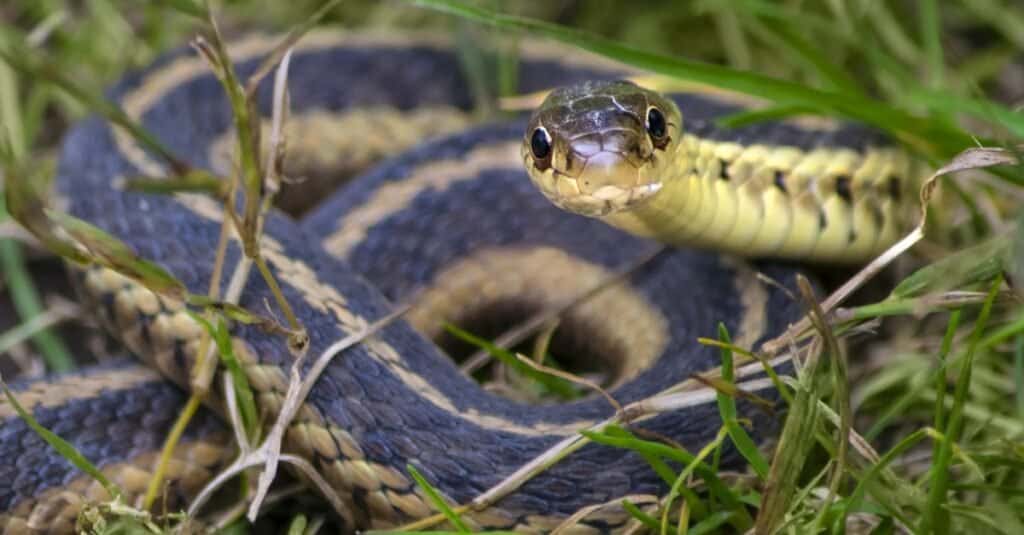
Like the ribbon snake, garter snakes can be found nearly everywhere in North America.
©K Quinn Ferris/Shutterstock.com
- Garter snakes are long, thin, and nearly everywhere in North America.
- San Francisco garter snakes are stunning with bright colors.
- Dekay’s brown snake is sometimes confused with garter snakes.
Ribbon Snake FAQs (Frequently Asked Questions)
Are ribbon snakes venomous?
No, these snakes aren’t venomous.
What is the difference between a ribbon snake and a garter snake?
Though they look a lot alike, ribbon snakes and garter snakes are different animals.
Garter snakes are thicker than ribbon snakes and longer as well. Ribbon snakes are found near water most of the time whereas garter snakes can be found near water or inland.
Look closely and you’ll see a ribbon snake has a white marking in front of each eye. A garter snake doesn’t have this marking.
How do ribbon snakes hunt?
They spot a frog, tadpole, or fish, then use their great speed to chase and capture it.
Are ribbon snakes aggressive?
No, these are timid snakes. This is why they are so popular as a pet.
Where do ribbon snakes live?
They live in North America. Some live in the eastern part of the United States while the territory of other types of ribbon snakes expands into the middle western and southern area of the country. Some types live on the Gulf Coast of Florida. There are some living in northern territory reaching up into Ontario Canada.
What do ribbon snakes eat?
Their diet includes frogs, tadpoles, and small fish.
Is a ribbon snake harmful?
No. They’re not poisonous or otherwise harmful.
Are ribbon snakes good pets?
Some people consider a ribbon snake a great pet. They are small and easy to handle. Plus, the bluestripe, yellow, tan, or white stripes on this snake make it an attractive pet.
How often do you feed a ribbon snake?
They need food two or three times each week.
Are ribbon snakes rare?
No. Ribbon snakes have a stable population and are Least Concern in terms of conservation status.
Thank you for reading! Have some feedback for us? Contact the AZ Animals editorial team.
Sources
- , Available here: https://www.eol.org/pages/1055203
- , Available here: https://en.wikipedia.org/wiki/Garter_snake
- (1970) https://www.wildlifenorthamerica.com/Reptile/Northern-Ribbon Snake/Thamnophis/sauritus-septentrionalis.html
- , Available here: https://herpneb.unl.edu/western-ribbonsnake
- , Available here: https://en.wikipedia.org/wiki/Thamnophis_sauritus_sauritus
- , Available here: https://www.iucnredlist.org/species/63991/12727431
- , Available here: https://reptilehow.com/garter-snake-vs-ribbon-snake/











